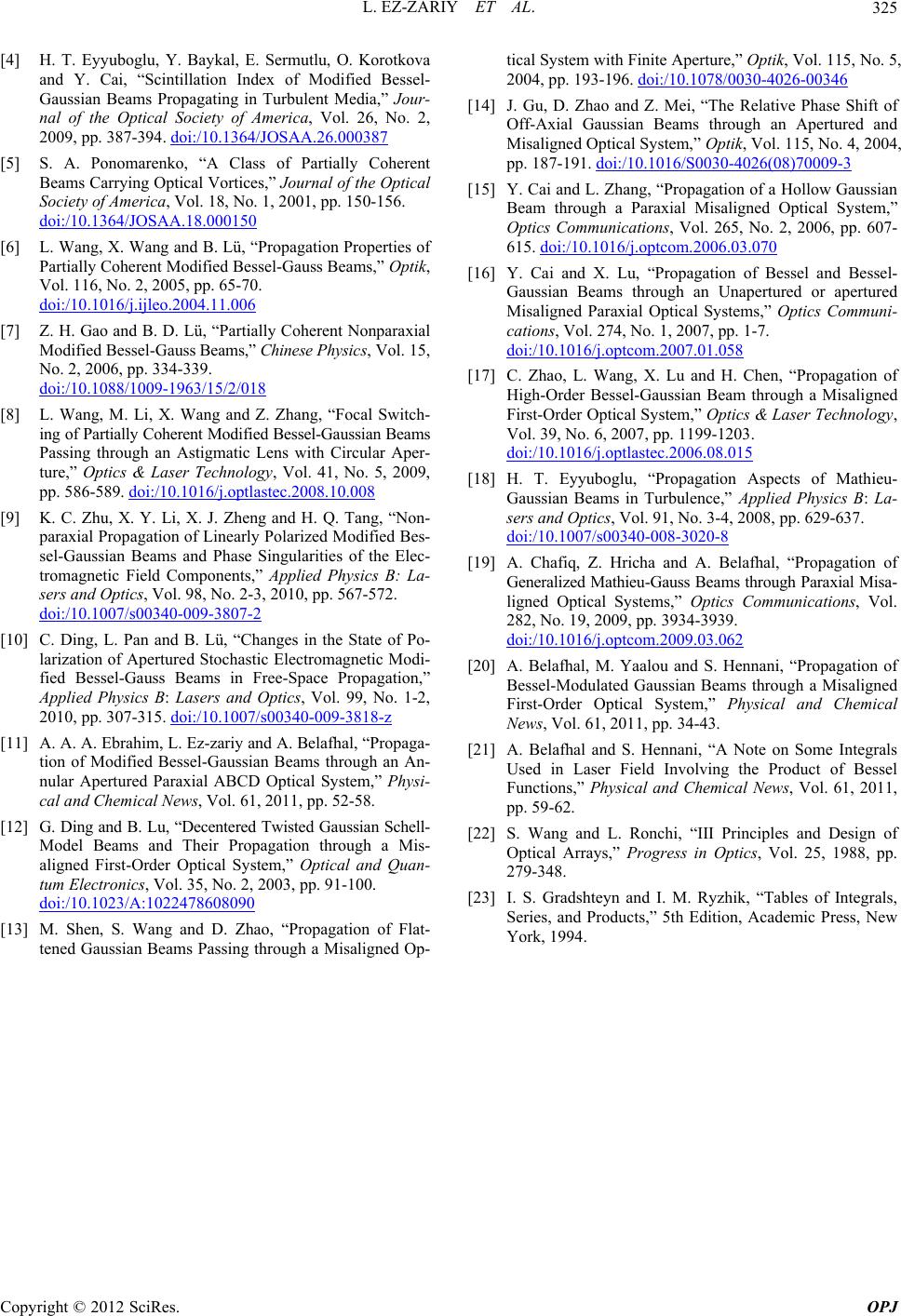
L. EZ-ZARIY ET AL. 325
[4] H. T. Eyyuboglu, Y. Baykal, E. Sermutlu, O. Korotkova
and Y. Cai, “Scintillation Index of Modified Bessel-
Gaussian Beams Propagating in Turbulent Media,” Jour-
nal of the Optical Society of America, Vol. 26, No. 2,
2009, pp. 387-394. doi:/10.1364/JOSAA.26.000387
[5] S. A. Ponomarenko, “A Class of Partially Coherent
Beams Carrying Optical Vortices,” Journal of the Optical
Society of America, Vol. 18, No. 1, 2001, pp. 150-156.
doi:/10.1364/JOSAA.18.000150
[6] L. Wang, X. Wang and B. Lü, “Propagation Properties of
Partially Coherent Modified Bessel-Gauss Beams,” Optik,
Vol. 116, No. 2, 2005, pp. 65-70.
doi:/10.1016/j.ijleo.2004.11.006
[7] Z. H. Gao and B. D. Lü, “Partially Coherent Nonparaxial
Modified Bessel-Gauss Beams,” Chinese Physics, Vol. 15,
No. 2, 2006, pp. 334-339.
doi:/10.1088/1009-1963/15/2/018
[8] L. Wang, M. Li, X. Wang and Z. Zhang, “Focal Switch-
ing of Partially Coherent Modified Bessel-Gaussian Beams
Passing through an Astigmatic Lens with Circular Aper-
ture,” Optics & Laser Technology, Vol. 41, No. 5, 2009,
pp. 586-589. doi:/10.1016/j.optlastec.2008.10.008
[9] K. C. Zhu, X. Y. Li, X. J. Zheng and H. Q. Tang, “Non-
paraxial Propagation of Linearly Polarized Modified Bes-
sel-Gaussian Beams and Phase Singularities of the Elec-
tromagnetic Field Components,” Applied Physics B: La-
sers and Optics, Vol. 98, No. 2-3, 2010, pp. 567-572.
doi:/10.1007/s00340-009-3807-2
[10] C. Ding, L. Pan and B. Lü, “Changes in the State of Po-
larization of Apertured Stochastic Electromagnetic Modi-
fied Bessel-Gauss Beams in Free-Space Propagation,”
Applied Physics B: Lasers and Optics, Vol. 99, No. 1-2,
2010, pp. 307-315. doi:/10.1007/s00340-009-3818-z
[11] A. A. A. Ebrahim, L. Ez-zariy and A. Belafhal, “Propaga-
tion of Modified Bessel-Gaussian Beams through an An-
nular Apertured Paraxial ABCD Optical System,” Physi-
cal and Chemical News, Vol. 61, 2011, pp. 52-58.
[12] G. Ding and B. Lu, “Decentered Twisted Gaussian Schell-
Model Beams and Their Propagation through a Mis-
aligned First-Order Optical System,” Optical and Quan-
tum Electronics, Vol. 35, No. 2, 2003, pp. 91-100.
doi:/10.1023/A:1022478608090
[13] M. Shen, S. Wang and D. Zhao, “Propagation of Flat-
tened Gaussian Beams Passing through a Misaligned Op-
tical System with Finite Aperture,” Optik, Vol. 115, No. 5,
2004, pp. 193-196. doi:/10.1078/0030-4026-00346
[14] J. Gu, D. Zhao and Z. Mei, “The Relative Phase Shift of
Off-Axial Gaussian Beams through an Apertured and
Misaligned Optical System,” Optik, Vol. 115, No. 4, 2004,
pp. 187-191. doi:/10.1016/S0030-4026(08)70009-3
[15] Y. Cai and L. Zhang, “Propagation of a Hollow Gaussian
Beam through a Paraxial Misaligned Optical System,”
Optics Communications, Vol. 265, No. 2, 2006, pp. 607-
615. doi:/10.1016/j.optcom.2006.03.070
[16] Y. Cai and X. Lu, “Propagation of Bessel and Bessel-
Gaussian Beams through an Unapertured or apertured
Misaligned Paraxial Optical Systems,” Optics Communi-
cations, Vol. 274, No. 1, 2007, pp. 1-7.
doi:/10.1016/j.optcom.2007.01.058
[17] C. Zhao, L. Wang, X. Lu and H. Chen, “Propagation of
High-Order Bessel-Gaussian Beam through a Misaligned
First-Order Optical System,” Optics & Laser Technology,
Vol. 39, No. 6, 2007, pp. 1199-1203.
doi:/10.1016/j.optlastec.2006.08.015
[18] H. T. Eyyuboglu, “Propagation Aspects of Mathieu-
Gaussian Beams in Turbulence,” Applied Physics B: La-
sers and Optics, Vol. 91, No. 3-4, 2008, pp. 629-637.
doi:/10.1007/s00340-008-3020-8
[19] A. Chafiq, Z. Hricha and A. Belafhal, “Propagation of
Generalized Mathieu-Gauss Beams through Paraxial Misa-
ligned Optical Systems,” Optics Communications, Vol.
282, No. 19, 2009, pp. 3934-3939.
doi:/10.1016/j.optcom.2009.03.062
[20] A. Belafhal, M. Yaalou and S. Hennani, “Propagation of
Bessel-Modulated Gaussian Beams through a Misaligned
First-Order Optical System,” Physical and Chemical
News, Vol. 61, 2011, pp. 34-43.
[21] A. Belafhal and S. Hennani, “A Note on Some Integrals
Used in Laser Field Involving the Product of Bessel
Functions,” Physical and Chemical News, Vol. 61, 2011,
pp. 59-62.
[22] S. Wang and L. Ronchi, “III Principles and Design of
Optical Arrays,” Progress in Optics, Vol. 25, 1988, pp.
279-348.
[23] I. S. Gradshteyn and I. M. Ryzhik, “Tables of Integrals,
Series, and Products,” 5th Edition, Academic Press, New
York, 1994.
Copyright © 2012 SciRes. OPJ